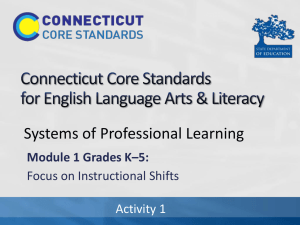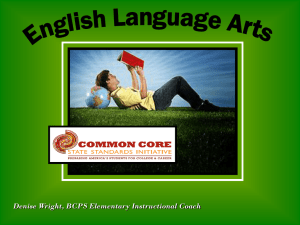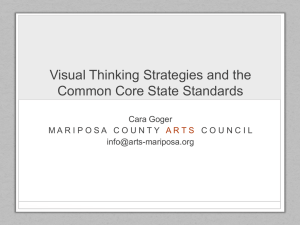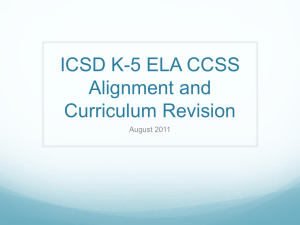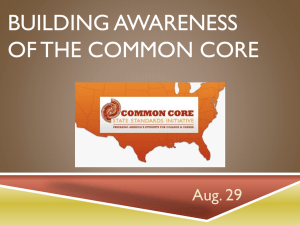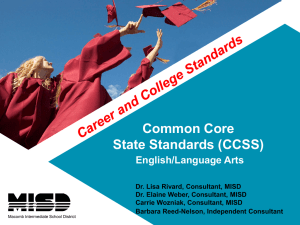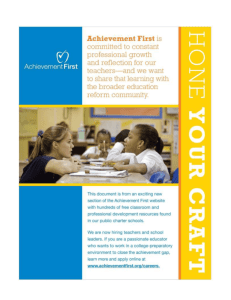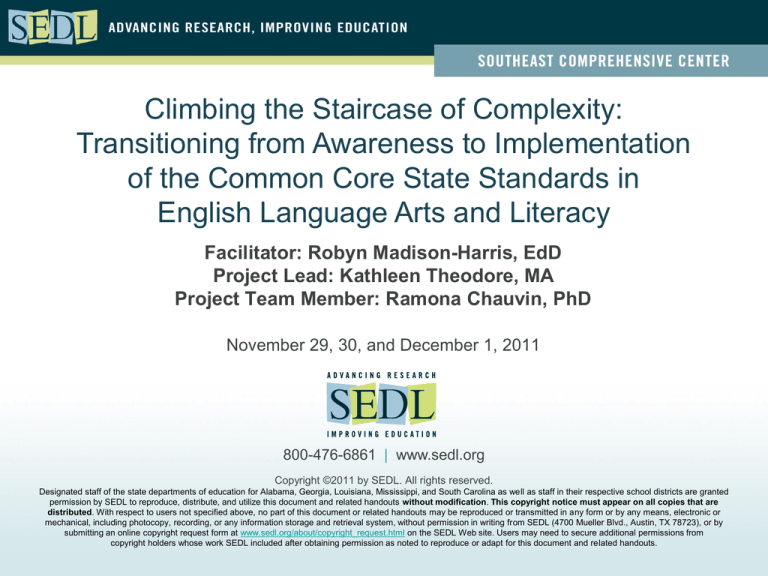
Climbing the Staircase of Complexity:
Transitioning from Awareness to Implementation
of the Common Core State Standards in
English Language Arts and Literacy
Facilitator: Robyn Madison-Harris, EdD
Project Lead: Kathleen Theodore, MA
Project Team Member: Ramona Chauvin, PhD
November 29, 30, and December 1, 2011
800-476-6861 | www.sedl.org
Copyright ©2011 by SEDL. All rights reserved.
Designated staff of the state departments of education for Alabama, Georgia, Louisiana, Mississippi, and South Carolina as well as staff in their respective school districts are granted
permission by SEDL to reproduce, distribute, and utilize this document and related handouts without modification. This copyright notice must appear on all copies that are
distributed. With respect to users not specified above, no part of this document or related handouts may be reproduced or transmitted in any form or by any means, electronic or
mechanical, including photocopy, recording, or any information storage and retrieval system, without permission in writing from SEDL (4700 Mueller Blvd., Austin, TX 78723), or by
submitting an online copyright request form at www.sedl.org/about/copyright_request.html on the SEDL Web site. Users may need to secure additional permissions from
copyright holders whose work SEDL included after obtaining permission as noted to reproduce or adapt for this document and related handouts.
ELA and Literacy CCSS Organization
SECTIONS
Standards for ELA and Literacy in History/Social Studies, Science,
and Technical Subjects K–5
Standards for ELA 6–12
Standards for Literacy in History/SS, Science, and Technical
Subjects 6–12
Supplemental Information and Explanations
ELA and Literacy CCSS Organization (Cont.)
• Appendix A – Research Supporting Key Elements
of the Standards; Glossary of Key Terms
• Appendix B – Text Exemplars and Sample
Performance Tasks
• Appendix C – Samples of Student Writing
Reading the Common Core State Standards
(CCSS) for English Language Arts/Literacy
The CCSS for English Language Arts (ELA)/Literacy are
composed of the following:
– Standards (what students understand and should be
able to do)
– College and Career Ready (CCR) Anchor Standards
– Strands (ELA K–12: Reading, Writing, Speaking and
Listening, and Language; 6–12 Literacy: Reading
and Writing)
Source: Content on slides 5–11 from Taking a Look at the English Language Arts
and Literacy Common Core Standards: A COI Discussion. Portsmouth, NH:
Center on Instruction. Adapted by SEDL with permission from COI.
Standards for ELA and Literacy in History/SS,
Science, and Technical Subjects K–5
Strands
Reading
Writing
Speaking/
Listening
Language
CCR Anchor
Standard
CCR Anchor
Standard
CCR Anchor
Standard
CCR Anchor
Standard
Literature K-5
Informational
Text K-5
Foundational
Skills
Strands
Reading
Literature & Informational
Writing
Speaking/
Listening
CCR Anchor
Standard
CCR Anchor
Standard
CCR Anchor
Standard
Language
CCR Anchor
Standard
Key ideas &
details
1.
2.
3.
Text types &
purpose
1.
2.
3.
Comprehension
& collaboration
1.
2.
3.
Craft &
structure
4.
5.
6.
Production &
distribution
of writing
4.
5.
6.
Presentation of
knowledge &
ideas
4.
5.
6.
7.
8.
9.
Research to
build
knowledge
7.
8.
9.
10.
Range of
writing
10.
Integration
of
knowledge &
ideas
Range/level
of text
complexity
Conventions
of standards
English
1.
2.
Knowledge
of language
3.
Vocabulary
acquisition &
use
4.
5.
6.
Foundational
Skills
Print Concepts
Phonological Awareness
Phonics & Word Recognition
Fluency
K–5 Standards
Standards for ELA 6–12
Strands
Reading
Writing
CCR Anchor
Standard
CCR Anchor
Standard
Literature 6-12
Informational
Text 6-12
Speaking/
Listening
CCR Anchor
Standard
Language
CCR Anchor
Standard
Strands
Reading
(Literature & Informational Text)
CCR Anchor
Standard
Writing
Speaking/
Listening
CCR Anchor
Standard
CCR Anchor
Standard
Language
CCR Anchor
Standard
Key ideas &
details
1.
2.
3.
Text types &
purpose
1.
2.
3.
Comprehension
& collaboration
1.
2.
3.
Craft &
structure
4.
5.
6.
Production &
distribution
of writing
4.
5.
6.
Presentation of
knowledge &
ideas
4.
5.
6.
7.
8.
9.
Research to
build
knowledge
7.
8.
9.
10.
Range of
writing
10.
Integration
of
knowledge &
ideas
Range/level
of text
complexity
Conventions
of standards
English
1.
2.
Knowledge
of language
3.
Vocabulary
acquisition &
use
4.
5.
6.
6–12 ELA Standards
Standards for Literacy in History, Social
Studies, Science, and Technical Subjects 6–12
Strands
Reading
CCR Anchor
Standard
Writing
CCR Anchor
Standard
Strands
Reading
CCR Anchor
Standard
Writing
CCR Anchor
Standard
Key ideas &
details
1.
2.
3.
Text types &
purpose
1.
2.
3.
Craft &
structure
4.
5.
6.
Production &
distribution
of writing
4.
5.
6.
7.
8.
9.
Research to
build
knowledge
7.
8.
9.
10.
Range of
writing
10.
Integration
of
knowledge &
ideas
Range/level
of text
complexity
6–12 Literacy in History, SS, Science, and Technology
Integrated Model of Literacy
• Close connections between strands
–
–
–
–
Foundational reading skills equal means to end
Focus on comprehension and meaning
Text complexity and range of reading throughout
High cognitive demand
• Interdisciplinary/shared approach
– Aligned with National Assessment of Educational
Progress (NAEP) reading framework
– Applied throughout school, including content areas
CCSS Instructional Shifts in ELA/Literacy
•
•
•
•
•
•
Shift 1: PK–5: Balancing Informational and Literary Text
Shift 2: 6–12: Knowledge in the Disciplines
Shift 3: Staircase of Complexity
Shift 4: Text-Based Answers
Shift 5: Writing From Sources
Shift 6: Academic Vocabulary
Source: Content on slides 12–13 from Instructional Shifts for the Common Core, by
EngageNY.org, 2011, Albany, NY: New York State Education Department (NYSED).
Copyright 2011 by NYSED. Adapted by SEDL with permission from EngageNY. Retrieved
from http://engageny.org/wp-content/uploads/2011/08/instructional_shifts.pdf
Focus on Shift 3: Staircase of Complexity
• To prepare students for the complexity of college and
career ready texts, each grade level requires a “step” of
growth on the “staircase.”
• Students read the grade-appropriate text around which
instruction is centered.
• Teachers are patient, create more time and space for
close, careful reading.
• Teachers provide appropriate scaffolding and supports to
meet students’ instructional needs and reading levels.
Range of Reading and Level of Complexity
• Reading Standard 10
“Read and comprehend complex literary and informational
texts independently and proficiently.” (p. 10)
• The Progression of Reading Standard 10
– Grade bands
– Text complexity requirements
– Scaffolding needs
Source: Content on slides 14–20 adapted by SEDL with permission from
CCSSI (2010)
Rationale for Text Complexity
• Goal of this standard: Students must be able to read
and comprehend independently and proficiently the
kinds of complex texts commonly found in college
and in careers.
• There is a reported decline in high-school level texts
(ACT, 2006); while at the same time, there is an
increase in the text difficulty of college and career
texts (Hayes & Ward, 1992; Milewski, Johnson,
Glazer, & Kubota, 2005).
Rationale for Text Complexity (Cont.)
• Some educators claim that school texts have declined
overall:
“The clear, alarming picture that emerges from the
[extensive body of research]. . .is that while the reading
demands of college, workforce training programs, and
citizenship have held steady or risen over the past fifty
years or so, K–12 texts have, if anything, become less
demanding.”
ELA-CCSS, Appendix A, 2010, p. 2
Note: See Appendix A, pp. 2–4, for specific research studies.
CCSS’ Model of Text Complexity
A Three-Part Model for
Measuring Text Complexity:
1. Qualitative Dimensions
1. Quantitative Dimensions
1. Reader and Task
Considerations
Qualitative Dimensions
• Levels of Meaning
• Structure
• Language Conventions and Clarity
Quantitative Dimensions
• Word length or frequency
• Sentence length
• Text length
• Text cohesion
Reader and Task Considerations
• Knowledge and Cognitive Demands
– Life Experiences
– Cultural and Literary Knowledge
– Content and Discipline Knowledge
• Mode(s) of Response
– Written
– Oral
– Graphic
• Purpose for Reading
• Degree of Scaffolding
Learning Task 1: Evaluating Texts for CCSS
1. Pair up with someone at your table, preferably someone from your
district. You will have 15 minutes for this task.
2. Find the following documents in your handouts:
– “Evaluating Texts for Common Core”
– The Longitude Prize
– “The Standards’ Grade-Specific Text Complexity Demands”
3. Use the “Evaluating Texts for Common Core” handout to evaluate the
text complexity of The Longitude Prize. Omit the Quantitative Evaluation
since Lexile or ATOS measures are not given for this text excerpt.
4. Use “The Standards’ Grade-Specific Text Complexity Demands” to
recommend the grade-level band.
5. Be prepared to share your evaluation, recommended grade-level band,
and rationale for your responses.
Learning Task 2: Reflecting on Shift 3 and
Text Complexity
1. Pair up with someone at your table, preferably someone from
your district, and discuss the following questions. You will have
5 minutes for this task.
a. What do the CCSS ask students to know and be able to do?
b. What changes, if any, in practice will we have to make to
address Shift 3, Reading Standard 10?
c. What challenges will we face as we make this shift?
d. When was the last time I was challenged by a text, and what
did I do to work within that frustration?
e. What supports will I need to provide for struggling students?
Learning Task 3: Differentiating Instruction and
Scaffolding a Complex Text
1. Pair up with someone at your table, preferably someone
from your district. You will have 5 minutes for this task.
2. You will need the following documents from your handouts
for this task:
– The Longitude Prize
– Tic-Tac-Toe Choice Board
3. Choose 3 tasks to complete on the Tic-Tac-Toe Choice
Board in such a way that you end up “winning” the game,
across, up and down, or diagonally.
4. Be prepared to share one of your responses with the whole
group.
References
ACT, Inc. (2006). Reading between the lines: What the ACT reveals about college
readiness in reading. Iowa City, IA: Author.
Common Core State Standards Initiative. (2010). Common Core State Standards
for English language arts & literacy in history/social studies, science, and
technical subjects. Retrieved from http://www.corestandards.org/thestandards/english-language-arts-standards
EngageNY (2011). Instructional shifts for the common core. Albany, NY: New York
State Education Department (NYSED). Retrieved from http://engageny.org/wpcontent/uploads/2011/08/instructional_shifts.pdf
Hayes, D. P., & Ward, M. (1992, December). Learning from texts: Effects of similar
and dissimilar features of analogies in study guides. Paper presented at the 42nd
Annual Meeting of the National Reading Conference, San Antonio, TX.
Milewski, G. B., Johnson, D., Glazer, N., & Kubota, M. (2005). A survey to evaluate
the alignment of the new SAT writing and critical reading sections to curricula
and instructional practices (College Board Research Report No. 2005-1/ETS
RR-05-07). New York, NY: College Entrance Examination Board.
Resources
See the handouts for a list of resources.
For more information, contact
Robyn Madison-Harris, EdD
Program Associate
Southeast Comprehensive Center at SEDL
3501 North Causeway Blvd., Suite 700
Metairie, LA 70002
800-644-8671
robyn.madison-harris@sedl.org

